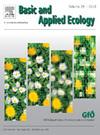Positive association between foliar silicon and extrafloral nectar in Vicia faba with application of methyl jasmonate
IF 3.5
2区 环境科学与生态学
Q2 ECOLOGY
引用次数: 0
Abstract
Plants have evolved direct and indirect defences against herbivores, which may come at a cost to other plant functions. Many plants can uptake and deposit large amounts of silicon within plant tissue, creating structures which can reduce herbivore performance. Silicon uptake can increase plant defenses against herbivores, but it has also been shown to trade-off with defensive phenolic compounds due to interference with jasmonic acid (JA) signaling. Additionally, plants can recruit predacious insects with extrafloral nectar (EFN), a sugar secretion not involved in pollination. It is currently unclear whether silicon uptake reduces other putative defences associated with the JA pathway, like EFN production. We used faba bean (Vicia faba) to identify potential trade-offs between silicon accumulation, phenolic content, and EFN production. We grew four genotypes of faba bean that varied in tannin content in control soil, or soil supplemented with silicon. After five weeks of growth, we exposed plants to either a buffer or methyl jasmonate (MeJA) solution to simulate an herbivory response. We measured EFN production at 24 and 48 hours after treatment, and harvested leaves to quantify silicon and phenolic content. We found silicon supplementation, but not MeJA treatment, increased foliar silicon concentration. Silicon supplementation did not affect foliar phenolic content or EFN sugar content. Silicon concentration (ppm) and MeJA treatment did not decrease foliar phenolic content or EFN sugar content. However, we found an interaction between silicon concentration (ppm) and MeJA treatment with EFN sugar content: across MeJA-treated plants, we detected a positive association between foliar silicon concentration and the amount of sugar (mg) in EFN. This study is the first to show MeJA can interact with leaf silicon concentration to alter EFN response, with the potential for cascading effects on other trophic levels.
施用茉莉酸甲酯对蚕豆叶面硅和花外花蜜的影响
植物进化出了直接和间接防御食草动物的能力,这可能是以牺牲植物的其他功能为代价的。许多植物可以在植物组织中吸收并沉积大量的硅,从而形成可以降低食草动物性能的结构。硅的吸收可以增加植物对食草动物的防御,但由于茉莉酸(JA)信号的干扰,它也被证明与防御性酚类化合物相权衡。此外,植物可以用花外花蜜(EFN)招募食肉昆虫,这是一种不参与授粉的糖分泌。目前尚不清楚硅的摄取是否会减少与JA途径相关的其他假定防御,如EFN的产生。我们使用蚕豆(Vicia faba)来确定硅积累、酚含量和EFN生产之间的潜在权衡。我们在对照土壤和补硅土壤中种植了四种不同单宁含量的基因型蚕豆。生长五周后,我们将植物暴露在缓冲液或茉莉酸甲酯(MeJA)溶液中,以模拟草食反应。我们在处理后24和48小时测量EFN产量,并收获叶片以量化硅和酚含量。我们发现补充硅,而不是MeJA处理,增加了叶面硅浓度。补硅对叶面酚含量和叶面糖含量没有影响。硅浓度(ppm)和MeJA处理没有降低叶面酚含量和叶面糖含量。然而,我们发现硅浓度(ppm)和MeJA处理与EFN糖含量之间存在相互作用:在MeJA处理的植株中,我们发现叶面硅浓度与EFN中糖含量(mg)呈正相关。这项研究首次表明,MeJA可以与叶片硅浓度相互作用,改变EFN反应,并可能对其他营养水平产生级联效应。
本文章由计算机程序翻译,如有差异,请以英文原文为准。
求助全文
约1分钟内获得全文
求助全文
来源期刊

Basic and Applied Ecology
环境科学-生态学
CiteScore
6.90
自引率
5.30%
发文量
103
审稿时长
10.6 weeks
期刊介绍:
Basic and Applied Ecology provides a forum in which significant advances and ideas can be rapidly communicated to a wide audience. Basic and Applied Ecology publishes original contributions, perspectives and reviews from all areas of basic and applied ecology. Ecologists from all countries are invited to publish ecological research of international interest in its pages. There is no bias with regard to taxon or geographical area.
 求助内容:
求助内容: 应助结果提醒方式:
应助结果提醒方式:


